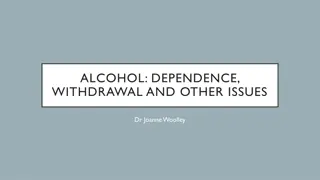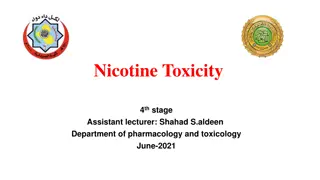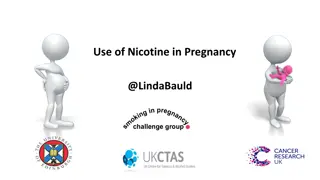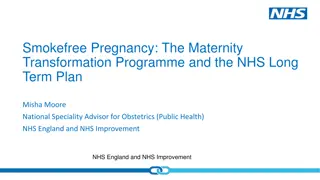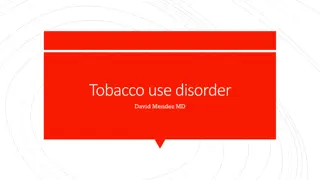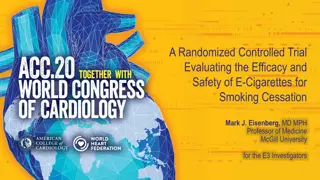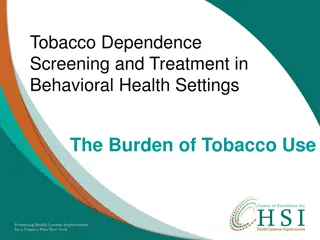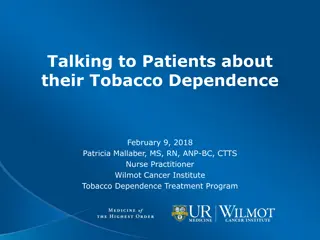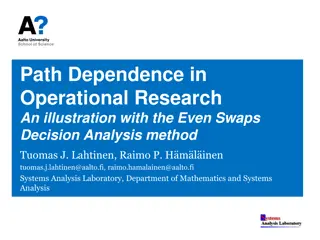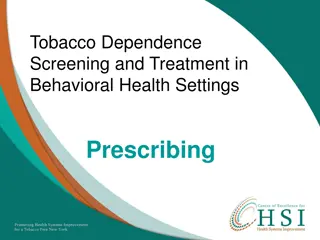Understanding Nicotine Dependence and Treatment
Nicotine dependence is a serious issue, but there are effective pharmacotherapies available to help individuals quit smoking. Nicotine, though not a carcinogen itself, is highly addictive and rapidly delivered to the brain through tobacco products. Treatments like pharmacotherapy significantly improve success rates in smoking cessation efforts. Seven medications are recommended for tobacco dependence, including nicotine inhalers, nasal sprays, bupropion, varenicline, nicotine patches, gum, and lozenges. It's crucial for clinicians to advocate for the use of these medications to support patients in quitting smoking.
Download Presentation

Please find below an Image/Link to download the presentation.
The content on the website is provided AS IS for your information and personal use only. It may not be sold, licensed, or shared on other websites without obtaining consent from the author. Download presentation by click this link. If you encounter any issues during the download, it is possible that the publisher has removed the file from their server.
E N D
Presentation Transcript
Nicotine Dependence and Treatment Steven J. Novak, MD February 9, 2018
Treating Tobacco Use and Dependence Numerous effective pharmacotherapies for smoking cessation now exist. Except in the presence of contraindications, these should be used with all patients attempting to quit smoking. Fiore et al, U.S. Dept of Health and Human Services, June 2000
Nicotine Not a carcinogen (as opposed to Tobacco) Addictive (when inhaled or delivered by Tobacco) Cigarettes are a potent Nicotine Delivery System Approximately 1mg/ cigarette <10 seconds to brain Addictive potential similar to cocaine and heroin
Cigarettes as Nicotine Delivery Systems Nicotine is inhaled deep into lungs Rapid delivery to left side of heart Pumped into brain and body Faster than injection into peripheral vein Onset of CNS action-seconds
Inhaled Nicotine
Tobacco Delivered Nicotine Stimulates the release of dopamine in the nucleus accumbens, in the brain s reward center. This release of dopamine is similar to that seen for other drugs of abuse, such as heroin and cocaine, and is thought to underlie the pleasurable sensations and the addictive behaviors associated with tobacco.
Pharmacotherapy Clinicians should encourage all patients attempting to quit to use effective medications for tobacco dependence treatment, except where contraindicated or for specific populations* for which there is insufficient evidence of effectiveness. * Includes pregnant women, smokeless tobacco users, light smokers, and adolescents. Medications significantly improve success rates. Fiore et al. (2008). Treating Tobacco Use and Dependence: 2008 Update. Clinical Practice Guideline. Rockville, MD: USDHHS, PHS, May 2008.
Medications For Tobacco Dependence Seven first-line medications reliably increase long-term smoking abstinence rates: Nicotine inhaler Nicotrol (Rx) Nicotine nasal spray Nicotrol NS (Rx) Bupropion SR Zyban (Rx) Generic (Rx) Varenecline Chantix (Rx) Nicotine patch Nicoderm CQ(OTC) Generic (OTC) Nicotine gum Nicorette (OTC) Generic (OTC) Nicotine lozenge Commit (OTC) Generic (OTC) OTC = over-the-counter / no prescription needed Rx=prescription required These are the only medications approved by the Food and Drug Administration (FDA) for tobacco dependence.
Considerations When Choosing Medications Patient preference Previous patient experiences with a specific agent (positive or negative) Patient characteristics (concern about weight gain, history of depression) Clinician familiarity with the medications Contraindications for selected patients
Nicotine Replacement Randomized, Placebo Controlled Studies consistently show doubling of abstinence rate Nicotine Patch (7-42+mg/day) Nicotine Gum 2 + 4 mg (10-24/day) Nicotine Lozenge 2 + 4mg (10-20/day) Nicotine Inhaler 4mg/inh (6-16/day) Nicotine Nasal Spray 1mg/dose (up to 40/day) Safe Effective 4-12 weeks or longer
Nicotine Replacement Therapy Reduces withdrawal symptoms Reduces cravings Delivers nicotine without toxins from tobacco Allows patient to focus on changing behavior Medications double chances of recovery
Nicotine Withdrawal Irritability/frustration/anger Anxiety Most symptoms manifest within the first 1 2 days, peak within the first week, and subside within 2 4 weeks. Difficulty concentrating Restlessness/impatience Depressed mood/depression Insomnia Impaired performance Increased appetite/weight gain Cravings Hughes. (2007). Nicotine Tob Res 9:315 327.
Nicotine Replacement Benefits Decreased irritability Decreased anxiety Improved concentration Improved mood Decreased cravings
Address Potential NRT Concerns Safety No evidence of increased cardiac risk No evidence of NRT causing cancer Ineffectiveness Provide Adequate dose (approximately 1mg/cigarette) Awareness of overdose symptoms (nausea, dizziness, headache) Fear of overdose Low addictive potential due to delivery system Fear of Addiction
Nicotine Replacement
Withdrawal Symptoms Over Time Nicotine Gum Placebo Impatience Irritability/Anger 1.5 1.5 Withdrawal Score 1.0 1.0 Mean Adjusted 0.5 0.5 0.0 0.0 1 2 3 4 5 6 7 8 9 10 1 2 Postcessation Weeks 3 4 5 6 7 8 9 10 Postcessation Weeks Anxiety/Tension Excessive Hunger Withdrawal Score 1.5 1.5 Mean Adjusted 1.0 1.0 0.5 0.5 0.0 0.0 1 2 3 4 5 6 7 8 9 10 1 2 Postcessation Weeks 3 4 5 6 7 8 9 10 Postcessation Weeks N = 40. Mean adjusted withdrawal scores are from an analysis of covariance with baseline cigarettes per day and baseline scores on the items shown as covariates. Gross et al. Psychopharmacology. 1989;98:334-341.
Transdermal Nicotine Patch 24 hr (21mg, 14mg, 7mg) A new patch is applied each morning Rotating placement site can reduce irritation Gradual release Plasma nicotine levels fluctuate less than with smoking Often under-dosed (~50% replacement)
Nicotine Patch Side Effects Mild itching and tingling in first hour Resolves quickly Vivid dreams or sleep disturbances May remove at bedtime if needed Local skin reactions (redness, burning, itching) Usually caused by adhesive Up to 50% of patients experience this reaction but fewer than 5% of patients discontinue therapy Rotate placement site Hydrocortisone cream as needed
Nicotine Patch Summary Disadvantages: Patients cannot titrate the dose to acutely manage withdrawal symptoms. Advantages: Provides consistent nicotine levels. Easy to use and conceal. Often under-dosed Once daily dosing associated with fewer compliance problems.
Nicotine Gum 2 mg (<25cig/day) and 4 mg (>25cig/day) Chew (release peppery taste) and park , continue for 30 minutes Absorbed in a pH basic environment, avoid acidic beverages 15 minutes pre and post dose (coffee, juice, soft drinks) Use enough pieces each day (10-15 usual)
Nicotine Gum Summary Disadvantages Might be problematic for patients with significant dental work. Patients must use proper chewing technique to minimize adverse effects. Need for frequent dosing can compromise compliance. Often under-dosed. Advantages Might satisfy oral cravings. Delays weight gain (4-mg strength). Patients can titrate therapy to manage withdrawal symptoms. A variety of flavors are available.
Nicotine Lozenge 2 mg (1st cig >30 minutes after waking) 4 mg (<30 minutes ) Place in mouth and allow to dissolve slowly Do not chew or swallow lozenge Avoid food and acidic beverages 15 minutes pre and post dose (coffee, juice, soft drinks) Use enough each day (usually 10-20/day)
Nicotine Lozenge Summary Disadvantages Need for frequent dosing can compromise compliance Advantages Might satisfy oral cravings. Delays weight gain (4-mg strength). Gastrointestinal side effects (nausea, hiccups, and heartburn) may be bothersome. Easy to use and conceal. Patients can titrate therapy to manage withdrawal symptoms. Often under-dosed. A variety of flavors are available.
Nicotine Inhaler Absorbed through oral mucosa Continuous puffing (80 puffs) over 20 minutes per dose (delivers 4 mg) 6-16 cartridges per day Eating or drinking before and during administration should be avoided Decreased delivery at cold temperatures
Nicotine Inhaler Summary Disadvantages Need for frequent dosing can compromise compliance. Initial throat or mouth irritation can be bothersome. Cartridges should not be stored in very warm conditions or used in very cold conditions. Often under-dosed. Advantages Patients can easily titrate therapy to manage withdrawal symptoms. The inhaler mimics the hand-to-mouth ritual of smoking.
Nicotine Nasal Spray Rapid delivery directly to nasal mucosa A dose is one spray (0.5mg) to each nostril Dosing should be 1 to 2 doses per hour, not to exceed 40 doses per day (or 5/hour) Usual dose 12-16/day Expect moderate to severe nasal and throat irritation early Avoid in patients with severe reactive airway disease Highest dependence potential of NRT s
Nicotine Nasal Spray Summary Disadvantages Nasal/throat irritation may be bothersome. Higher dependence potential. Need for frequent dosing can compromise compliance. Patients with chronic nasal disorders or severe reactive airway disease should avoid the nasal spray. Advantages Patients can easily titrate therapy to rapidly manage withdrawal symptoms. May be more effective with more highly dependent patients.
Bupropion Monocyclic antidepressant Inhibits re-uptake of Norepinephrine and Dopamine Affects Dopaminergic activity on reward pathways Doubles abstinence rates Begin 1-2 weeks before quit attempt 150mg x 3 days, then 150mg bid (300mg/day) for 6-12 weeks Up to 6 months as maintenance
Bupropion Summary Disadvantages Seizure risk increased. Advantages Easy to use oral formulation. Contraindications preclude use in some patients. Convenient dosing. Delays weight gain. Beneficial for patients with concurrent depression.
Varenicline Partial agonist at nicotinic acetylcholine receptor >Doubles abstinence rate 0.5mg x 3 days, 0.5mg twice daily x 4 days, then 1mg twice a day Reduce dose in severe renal impairment Take after eating with a full glass of water 12 weeks Up to 6 months as maintenance
Varenicline Side effects: Nausea Abnormal dreams/ insomnia Reduce dose in severe renal impairment Patients should be advised to use caution driving or operating machinery Monitor for changes in mood and behavior
Tobacco Smoke Interactions with Medications Clinically significant interactions result from the combustion products of tobacco smoke . Tobacco smoke is a potent inducer of 1A2 and 2E1 P450 isoenzymes Constituents in tobacco smoke (polycyclic aromatic hydrocarbons) enhance the metabolism of other drugs, resulting in a reduced pharmacologic response. Fiore et al. (2008). Treating Tobacco Use and Dependence: 2008 Update. Clinical Practice Guideline. Rockville, MD: USDHHS, PHS, May 2008.
Tobacco Smoke Interactions with Medications Tobacco use can result in a 40% reduced serum level of some medications Abstinent Tobacco users can experience side effects from supra-therapeutic drug levels of medications such as Clozapine Olanzapine Fluvoxamine Theophylline Caffeine *** Amitriptyline Nortriptyline Imipramine Haloperidol Clomipramine
Caffeine and Smoking Caffeine is 99% metabolized by CYP1A2 Median caffeine concentrations are 2-3x higher in non-smokers When a patient quits smoking, their caffeine intake should be reduced by to avoid excessive caffeine levels Symptoms of caffeine toxicity can mimic those of nicotine withdrawal Clin Pharmacokinet 1999; 36:425-38
Weight Gain Concerns Medications can delay post-cessation weight gain Nicotine Replacement In particular, 4mg Nicotine Gum and Nicotine Lozenge Dose response relation Bupropion Fiore et al. (2008). Treating Tobacco Use and Dependence: 2008 Update. Clinical Practice Guideline. Rockville, MD: USDHHS, PHS, May 2008.
Highly Dependent Smokers Higher dose preparations of NRT are effective in highly dependent smokers Combination NRT therapy is particularly effective in suppressing withdrawal symptoms Fiore et al. (2008). Treating Tobacco Use and Dependence: 2008 Update. Clinical Practice Guideline. Rockville, MD: USDHHS, PHS, May 2008.
Combination Pharmacotherapy Combination NRT Long-acting formulation (Nicotine Patch) Produces relatively constant levels of nicotine PLUS Short-acting formulation (Nicotine Gum, Inhaler, or Nasal Spray) Allows for acute dose titration as needed for nicotine withdrawal symptoms Bupropion SR + Nicotine Patch Fiore et al. (2008). Treating Tobacco Use and Dependence: 2008 Update. Clinical Practice Guideline. Rockville, MD: USDHHS, PHS, May 2008.
Co-occurring Addiction/ Mental Illness and Tobacco Dependence Treatment -70% expressed an interest in stopping tobacco use in the past year. People with mental illness and chemical dependency express an interest in stopping tobacco use just as often as smokers in the general population. -Patients with mental illness can successfully stop tobacco use Often need more frequent and more intense treatment
Intensive Treatment for People with Co-occurring Addiction/ Mental Illness A general rule regarding smoking cessation efforts for this population: more is better. More intensive treatment frequency/ duration More intensive pharmacotherapy Increased dose Increased combinations Longer duration Involving more than one type of provider leads to greater success.
NRT in patients not ready to quit The use of NRT more than doubled the likelihood that a smoker would be abstinent at 12 months, despite the smoker s unwillingness to make a quit attempt at the time of initial assessment Fiore et al. (2008). Treating Tobacco Use and Dependence: 2008 Update. Clinical Practice Guideline. Rockville, MD: USDHHS, PHS, May 2008.
Summary Clinicians should encourage the use of effective medications by all patients attempting to quit tobacco First-line medications reliably increase long- term tobacco abstinence rates Use of effective combinations of medications should be considered
Summary Use of high dose NRT should be considered and encouraged in highly dependent tobacco users Use of extended duration NRT should be offered and encouraged Consider NRT prior to quit date Treat both the physiological and behavioral components of tobacco dependence





